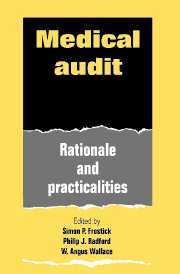Book contents
- Frontmatter
- Contents
- List of contributors
- Foreword
- Foreword
- 1 Introduction
- 2 Audit: historical and future perspectives
- 3 Audit philosophy
- 4 Medical audit: a view from the centre
- 5 Audit: a view from the Royal College of Surgeons of England
- 6 The regional viewpoint
- 7 Medical audit: the needs of the District Health Authorities
- 8 Resource management and budget holding
- 9 Unit and district information systems
- 10 Read codes and medical audit
- 11 Data capture direct from doctors
- 12 Computer systems: practice, limitations and pitfalls
- 13 Paediatric audit
- 14 Audit in obstetrics and gynaecology
- 15 Audit in general surgery
- 16 Orthopaedic audit: guidelines and hints
- 17 Installing audit in general practice and general dental practice
- 18 Clinical audit in psychiatry. Models for audit in mental health
- 19 Audit in anaesthesia
- 20 Audit in intensive care
- 21 Medical audit: lessons from the USA
- 22 Quality control in health care: the Dutch experience
- 23 Medical audit: experience from Sweden
- 24 Performance indicators
- 25 Measuring outcome and quality control
- 26 Audit: will it work?
- 27 What has been achieved so far?
- 28 A practical guide to audit
- Index
1 - Introduction
Published online by Cambridge University Press: 30 September 2009
- Frontmatter
- Contents
- List of contributors
- Foreword
- Foreword
- 1 Introduction
- 2 Audit: historical and future perspectives
- 3 Audit philosophy
- 4 Medical audit: a view from the centre
- 5 Audit: a view from the Royal College of Surgeons of England
- 6 The regional viewpoint
- 7 Medical audit: the needs of the District Health Authorities
- 8 Resource management and budget holding
- 9 Unit and district information systems
- 10 Read codes and medical audit
- 11 Data capture direct from doctors
- 12 Computer systems: practice, limitations and pitfalls
- 13 Paediatric audit
- 14 Audit in obstetrics and gynaecology
- 15 Audit in general surgery
- 16 Orthopaedic audit: guidelines and hints
- 17 Installing audit in general practice and general dental practice
- 18 Clinical audit in psychiatry. Models for audit in mental health
- 19 Audit in anaesthesia
- 20 Audit in intensive care
- 21 Medical audit: lessons from the USA
- 22 Quality control in health care: the Dutch experience
- 23 Medical audit: experience from Sweden
- 24 Performance indicators
- 25 Measuring outcome and quality control
- 26 Audit: will it work?
- 27 What has been achieved so far?
- 28 A practical guide to audit
- Index
Summary
The audit of medical practice is neither a new concept nor a new activity. All medical practitioners have examined the effects of their treatment and have assessed outcome for centuries. The major advances in medical practice, particularly during the twentieth century, would not have occurred without observing and assessing the effects of treatment regimes. The main effect of the changes indicated in the HM Government White Paper ‘Working for Patients’ and subsequently the National Health Service and Community Care Act (1990) and the directives from the various Royal Colleges has been to emphasise the need for audit activity and to introduce a more formal basis to audit. Audit has also been linked to the need for the cost-effective use of resources.
The purposes of this book are firstly to describe the philosophy of audit in medical practice; secondly to establish the types of information required by the different groups interested in audit; thirdly to outline the ways in which audit activity is being undertaken in various specialties; and fourthly to suggest a coherent pattern for audit and make recommendations for the acquisition and storage of large volumes of information.
Definitions
The general public concept of audit is the annual review of the ‘books’ of a business.
- Type
- Chapter
- Information
- Medical Audit , pp. 1 - 4Publisher: Cambridge University PressPrint publication year: 1993
- 2
- Cited by

